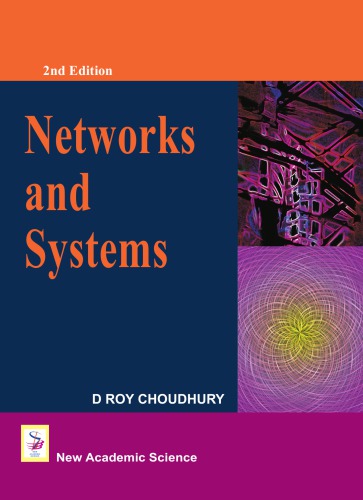

Most ebook files are in PDF format, so you can easily read them using various software such as Foxit Reader or directly on the Google Chrome browser.
Some ebook files are released by publishers in other formats such as .awz, .mobi, .epub, .fb2, etc. You may need to install specific software to read these formats on mobile/PC, such as Calibre.
Please read the tutorial at this link: https://ebookbell.com/faq
We offer FREE conversion to the popular formats you request; however, this may take some time. Therefore, right after payment, please email us, and we will try to provide the service as quickly as possible.
For some exceptional file formats or broken links (if any), please refrain from opening any disputes. Instead, email us first, and we will try to assist within a maximum of 6 hours.
EbookBell Team

4.3
98 reviews
ISBN 10: 1906574243
ISBN 13: 9781906574246
Author: D Roy Choudhury
Chapter 1
Introduction
Circuit Components
Assumptions for Circuit Analysis
Definitions
Conservation of Energy
Source of Electrical Energy
Standard Input Signals
Sinusoidal Signal
Kirchhoff's Laws
Chapter 2
Signals
The Continuous-Time Unit Step and Unit Impulse Functions
The Discrete-Time Unit Impulse and Unit Step Sequences
Even and Odd Signals
Periodic Signal
Time Scaling
Reflection
Time Shifting
Types of Sequences
Impulse Response
Discrete Convolution
New Approach for Solving Problems
Invertibility and Inverse Systems
Causality
Linearity
Chapter 3
Kirchhoff's Laws
Source Transformation
General Network Transformations
Mesh and Node Analysis
Network Equations for RLC Network
Magnetic Coupling
Chapter 4
Introduction
Evaluation of Fourier Coefficients
Waveform Symmetry
Fourier Series in Optimal Sense
Exponential Form of Fourier Series
Effective Value
Fourier Transform
Effective Value of a Non-sinusoidal Wave
Chapter 5
Introduction
Laplace Transformation
Some Basic Theorems
Gate Function
Impulse Function
Laplace Transform of Periodic Functions
Chapter 6
Solution of Linear Differential Equation
Heaviside's Partial Fraction Expansion
Kirchhoff's Laws
Solution of Network Problems
Convolution Integral
Convolution Theorem
Evaluation of the Convolution Integral
Inverse Transformation by Convolution
Impulse Response
Graphical Convolution
Chapter 7
Introduction
Mechanical Elements
D'Alembert's Principle
Force-Voltage Analogy
Force-Current Analogy
Mechanical Couplings
Electromechanical System
Liquid Level System
Chapter 8
Graph of a Network
Trees, Cotrees and Loops
Number of Possible Trees of a Graph
Incidence Matrix
Cut-set Matrix
Tie-set Matrix and Loop Currents
Inter-relationship Among Various Matrices
Analysis of Networks
Network Equilibrium Equation
Duality
Chapter 9
Superposition Theorem
Reciprocity Theorem
Thevenin's Theorem
Norton's Theorem
Millman's Theorem
Maximum Power Transfer Theorem
Substitution Theorem
Compensation Theorem
Tellegen's Theorem
Chapter 10
Series Resonance
Parallel Resonance
Chapter 11
Nepers, Decibels
Lattice Attenuator
T-Type Attenuator
π-Type Attenuator
L-Type Attenuator
Ladder Type Attenuator
Insertion Loss
Chapter 12
Introduction
Characterisation of Linear Time-invariant Two-port Networks
Open-circuit Impedance Parameters
Short-circuit Admittance Parameters
Transmission Parameters
Inverse Transmission Parameters
Hybrid Parameters
Inverse Hybrid Parameters
Interrelationships between the Parameters
Interconnection of Two-port Networks
Two-port Symmetry
Input Impedance in Terms of Two-port Parameters
Output Impedance
Image Impedance
Transistors as Two-port Active Network
Network Components
Chapter 13
Introduction
Image Impedance
Hyperbolic Trigonometry
Propagation Constant
Properties of Symmetrical Network
Filter Fundamentals
Chapter 14
Filter Characteristics
First-Order Low-pass Filter
Higher Order Low-pass Filter
First-Order High-pass Filter
Chapter 15
State Variable Approach
State Space Representation
Transfer Function
Linear Transformation
Diagonalization
State Transition Matrix
Solution to Non-homogeneous State Equations
Minimal Set of State Variable Formulation
Chapter 16
Ports and Terminal Pairs
Determinant and Cofactors for Determining Network Function
Network Functions
Poles and Zeros
Necessary Conditions for Driving-point Function
Application of Network Analysis in Deriving Network Functions
Time Domain Behaviour from Pole-zero Plot
Transient Response
Chapter 17
Introduction
Positive Real Functions
Driving Point and Transfer Impedance Function
LC Network
Two-terminal R-L Network
Two-terminal R-C Network
Chapter 18
Introduction
Block Diagram Representation
Signal Flow Graph
Stability Criterion of Feedback System
Routh-Hurwitz Stability Criterion
Chapter 19
Network Response due to Sinusoidal Input Functions
Plots from s-Plane Phasors
Magnitude and Phase Plots
Polar Plot
Bode Plot (Logarithmic Plot)
Measure of Relative Stability
Root Loci
Nyquist Stability Criterion
lecture notes in networks and systems scimago
wireless communication networks and systems pdf
d roy choudhury networks and systems
intelligent networks and systems society
computer networks and systems administration
network and systems administrator
Tags: D Roy Choudhury, Networks, systems